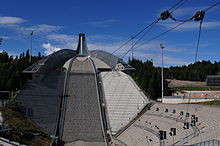Electronic camera


As electronic camera refers to devices that the electronic capture moving images are used, which can then be transferred directly or recorded on various storage media. Electronic cameras have existed in the professional field since the beginning of electronic image transmission ; they are to be regarded as forerunners of the video camera .
History and Development
The basics of electronic cameras go back to 1883, when Paul Nipkow came up with the idea for his Nipkow disc . In 1923 the iconoscope was invented, the first fully electronic image scanner. Only the latter technology was able to gain acceptance, which, after some improvements, was not replaced by CCD sensors and CMOS sensors until the early 1990s .
Types of electronic moving image cameras
Electronic cameras are used to record high quality images. Since these are made of very high quality materials, these cameras are correspondingly expensive. There are different types of cameras for electronic cameras.
Studio camera
Studio cameras produce high quality images similar to those used in film productions, but are designed for use in television studios or for outdoor broadcasts. Studio cameras do not have their own recording option, but instead carry image and sound signals via a fiber optic or triax line to an OB van or a control room. There, the signals are processed, recorded or broadcast directly. Almost all technical parameters and settings of the camera are also monitored and changed from there, so that hardly any settings have to be made on the device itself.
Since studio cameras can be very heavy, there are special massive mobile stands with three double wheels at 120 ° to each other and a five-section telescopic central column that is continuously adjustable in height. Technically correct, they are called pedestals . This construction, controlled by pressure tanks, balances the weight of the camera and the pan head, so that the cameraman can move the camera vertically without any effort and also let it rest at any height. Since the steering geometry of the solid rubber wheel pairs, which are arranged in an isosceles triangle, is arranged in such a way that they are always parallel to each other in every steering wheel position, the pedestals drive in a crab, which enables both jerk-free starting / braking and blur-free cornering. The design-related combination of horizontal tracking shots and vertical movements at the same time “on”, as well as the quick disappearance / hiding when a camera “has to be out of the picture” - which often happens - make up the special features of this type of tripod.
The studio camera shown on the stamp is part of the so-called. "Second generation" of color television cameras, it represents the "KCU 40" model of the company FESE (then a division of Bosch , now Grass Valley Germany) in Darmstadt, nor equipped with Plumbicon -Bildaufnahmeröhren . The camera is on a pedestal from Vinten (GB), the combination of the two devices has long been considered a “classic”: From the early 1970s onwards, it was standard equipment used in large numbers in practically all television stations. The KCU was still in use until the end of the 1980s, the pedestals (coll. Pump stands) have remained the standard in studios and on outside broadcasts to this day.
Electronic reporting camera (EB)
In contrast to the studio cameras, EB cameras have a built-in recorder that compresses the image and sound signals and saves them on a recording medium. Today memory cards or optical storage are mostly used for this purpose, in the past mostly video cassettes . Most importantly, cameras for electronic reporting must be light, but still record good image material. They therefore often share a common basis with studio cameras from the same manufacturer, but are more compact and do without some functions.
Digital cinema camera / EC camera
This youngest group of electronic cameras is used for feature film production and the main focus is on maximum image quality. These cameras are in competition with the classic 35 mm film. The introduction of the digital cinema camera began with devices in the HDCAM standard by George Lucas , and hundreds of feature films have already been produced and shown with digital cameras. Sony is a pioneer of the market and brought the first digital cinema camera ("CineAlta") to the market in 1997. Later came Panasonic ( "Varicam") and Arri added. Companies from other areas of television technology and new companies such as Blackmagic Design , RED or AJA also recognized the opportunities in the market and are now offering cinema cameras.
Cinema cameras usually have a built-in or dockable recorder, but it is common practice to connect external recorders in order to take advantage of better compression techniques or the advantages of another recording system.
Other types of cameras
- Film camera
- camcorder
- Still camera
- Camera (overview)

